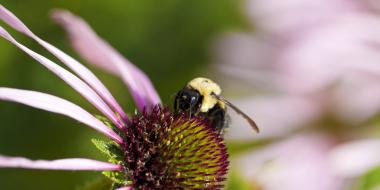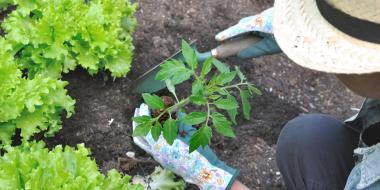It’s a no-brainer that mulch gives a garden a finished and pulled-together look. But mulch is so much more than just an accessory! Whether your garden is a sprawl of perennials, a riot of annuals, or even a tidy line-up of trees, mulch works hard to let it do what it wants to do most: grow! Here's why mulch is your garden's best friend.
What's so great about mulch?
- Mulch is great at moderating soil temperature. It prevents both overheating and flash-freezing of the soil.
- It protects against the impact of rain. This means that your lovingly amended (adding beneficial elements to improve condition) soil will not erode or compact.
- Mulch prevents evaporation by absorbing water into its porous material and then slowly releases the water, letting it percolate into the ground.
- It breaks down over time, adding beneficial organic matter and nutrients to your soil.
- Mulch helps keep weeds out of your garden beds — there’s nothing those opportunistic weeds like better than bare soil!
Which mulch is for you?
Annual garden beds (vegetables or flowers)
Annuals prefer a finer mulch than perennials. Ideally, you want the material to break down within six months to a year, to get all those great “humusy” nutrients into the soil as quickly as possible.
Shredded fall leaves
These make the best mulch! Bonus points if you use moist fall leaves that were over-wintered in sealed garbage bags to help create a wonderful leaf mould, which has a humus-like, crumbly structure that’s ready for the earthworms to work into the soil as soon as you lay it down. If you don’t have a mower to mulch your leaves you can still use them whole; but keep in mind breaking them up by hand or flipping them over may be necessary if they get too matted, making it difficult for water and air to get down into the soil

Dried grass clippings
Collect these after mowing. They break down quickly and are easy to work around small plants. They will need more frequent applications, however, and need to be dry before spreading, or they will get matted and smelly.
Straw
Another good option for annual areas. (Avoid hay, as it contains seeds.) You will likely get a little bit of grass sprouting from the straw, but it’s loosely rooted and very easy to hand pull. Straw between your rows of vegetables and around strawberry plants can also help keep fruits from lying in the mud when the stalks bend. And it can be thickly laid (4-6” deep) in areas where your main concern is weed suppression.

Triple-shredded wood mulch
This can also be used, although the lignin content in the wood tends to favour a more fungal-dominant soil which is better-suited for perennials, shrubs, and trees.
Annual beds can be mulched in the fall to protect the soil over winter, but you may want to pull the mulch back in spring to let the soil warm up and dry out a bit before planting, so that you can get your seeds in the ground earlier. Spread the mulch out again after sowing seeds, or once plants have emerged.
Mulch for perennial garden beds
Perennial beds prefer a bulkier mulch. This means you can take advantage of those gorgeous, chunky wood mulches! Feel free to use shredded leaf mulch, if you’d prefer. Just remember that it will definitely call for a mid-season reapplication.
Wood chip and bark mulches
Great for perennial gardens! The larger the chips, the longer the mulch will take to break down. If you’re working with smaller, more delicate plants, try to keep the chips medium-sized. Ask yourself what you need your mulch to do for you? If you’re looking for water conservation, use wood chips. If you live in a damp area where fungus can be a problem, try bark, which tends to retain less water than the chip mulch.
A note on dyed mulches: Mulches can come in some pretty eye-catching colours that are purportedly made with vegetable-based dyes. But use at your own discretion and please avoid them around anything edible.
Mulch for shrubs and trees
Shrubs and trees should have rings of wood mulch around them to prevent grass from taking up habitation. (If you’re a keen permaculturalist, you may have companion plants in a supportive guild around your tree.) Since grass prefers bacterial-dominant soil and perennials and woody things like fungal-dominant soil, you create competition between the two if you allow them to share the same space.
To avoid this tension, create a ring of mulch around the base of the tree or shrub. At minimum, aim for a radius of about one foot, but you can certainly stretch the radius of the mulch all the way out to the drip line (or as far out as the branches reach). Lay your chosen mulch two to four inches thick and be prepared to top dress with fresh mulch when it gets thinner than one inch thick (usually within one to four years). Avoid creating a “volcano” of mulch at the trunk site. Instead, keep it level and a few inches away from the trunk. This allows for air exchange in the surface feeder roots; prevents water from pooling and creating bark rot; and hampers secret bark nibbling from voles, mice, and other critters. The more finely shredded the mulch is, the faster it will break down and amend the soil, and the more often it will need replacing. Choose the size of chips based both on your needs and the soil’s needs.
Get out there, grab your garden’s best friend, and protect that soil your plants need to thrive in! Pick mulch based on the available resources, the types of plants you are mulching around, and what your goals are with the mulch. More work up front means less work in the long term. Your happy plants and happier soil organisms will thank you!






